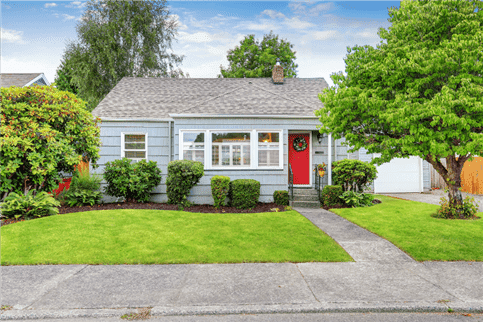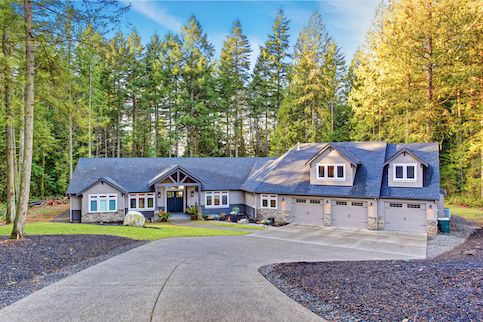A major perk of homeownership is the ability to build equity. Home equity is the difference between what your home is worth and how much you owe on your mortgage.
As a homeowner, you can convert equity into cash by selling your home to turn it into a profit or borrow against your equity to pay for home improvements or other expenses, like debt. Here’s how to use home equity.
Key Takeaways:
- Home equity represents the portion of your home’s value that you truly own and is calculated by subtracting your mortgage balance from your home’s current value.
- You can borrow equity with a cash-out refinance, home equity loan or home equity line of credit (HELOC).
- You build equity by paying down your mortgage and increasing the value of your home.
What Is Home Equity?
What does it mean to have equity in a house?
Home equity represents the portion of your home’s value that you own. It’s the difference between what your home is worth and how much you owe on your mortgage.
Your home quality increases as you make payments and pay down your mortgage. Your equity also increases when your home value increases.
Though less common, your home equity can decrease if your home’s value falls below what you owe on your mortgage. This is called negative equity.
How To Calculate Your Home Equity
To calculate your home equity, take your home’s current market value and subtract what you owe on your mortgage. You can get a home appraisal or research comparable home sales in your area to estimate the current value.
How Does Equity Work?
Let’s imagine you bought your home for $300,000. If your home appraises for $400,000 today and your current mortgage balance is $275,000, you’d have $125,000 in equity, or 31% equity.
How To Build Home Equity
Here are some ways to build home equity:
Make A Big Down Payment
Home equity begins when you make a down payment. You can start your homeownership journey with more home equity by making a big down payment.
Here’s an example:
Let’s imagine you buy a $400,000 home. If you make a 5% down payment, you’ll begin with $20,000 in equity. But if you make a 10% down payment, you’ll start with $40,000 in home equity.
Make Your Monthly Mortgage Payments
As you make mortgage payments, you reduce what you owe and build equity. Mortgages are amortized, meaning that at the beginning of the amortization schedule, a larger portion of your payment goes to interest compared to principal. But that changes over time, and you’ll build equity more quickly the further along you are in paying off your mortgage.
Pay More Than The Minimum
You can build equity in a house by paying more on your mortgage. This practice can help you pay your mortgage off faster.
Here are two common ways to do this:
- Make biweekly payments: By paying half of your monthly payment every other week, you’ll make 26 payments a year, which equates to 13 monthly payments.
- Make an additional $100 payment every month.
Pro tip: Ensure any extra payments you make are applied to your loan’s principal balance.
Renovate And Add Curb Appeal
You can build equity in a house by increasing the value of your home. Some potential ways to boost value include adding an extra bedroom or renovating an outdated kitchen. Investing in landscaping and improving curb appeal can also increase home value.
Own Your Home For At Least A Few Years
Equity can build more slowly in the early years of mortgage repayment. Experts suggest that owning your home for a minimum of 5 years could help you build enough equity to break even on your investment. However, this is only a general guideline. The longer you own your home, the more likely its fair market value will increase, helping you build more equity over time.
What’s Your Goal?
Buy A Home
Discover mortgage options that fit your unique financial needs.

Refinance
Refinance your mortgage to have more money for what matters.
Tap Into Equity
Use your home’s equity and unlock cash to achieve your goals.
How To Use Home Equity
If you’re a homeowner, it’s beneficial to know how to use home equity. You can convert your equity into cash by selling your home or borrowing against your equity.
Here are some reasons you may want to tap into your home equity:
Renovate Or Repair Your Home
Home repairs and renovations can increase the value of your property and help you build more equity. If you’re planning renovation projects, consider using your home’s equity to pay for the work. Borrowing against your equity typically costs less due to lower interest rates than using a credit card or personal loan.
Consolidate Debt
If you have high-interest debt, like credit card debt, you can use a home equity loan for debt consolidation. You can save money by getting a new loan with a lower interest rate than what typically comes with credit card debt.
Buy A New Home
Home equity can be helpful if you want to sell your home and buy a new one. Let’s say the home you’re selling is worth $400,000, and you’ve built $100,000 worth of equity. If your home sells for $400,000, you’ll have a significant profit after repaying your mortgage and paying closing costs, and you can use the profit as a down payment on your new home.
Having equity can help you make a larger down payment and start owning your next home with more equity or help you afford a more expensive property.
Remove Private Mortgage Insurance
If you take out a conventional loan with a down payment that’s less than 20%, you’ll be responsible for paying for private mortgage insurance (PMI).
PMI offers you no protection as a homeowner. Instead, it protects the lender in the event you default on your loan. But guess what? You can cancel PMI once you achieve 20% home equity. This can serve as an incentive for homeowners to build equity.
Start A Business Or Pay For School
If you need to pay for business or education costs, borrowing your home equity can be an affordable solution. Borrowing equity can help you cover business and tuition expenses. You can get a lower interest rate than you would with personal loans or student loans.
Cover Other Major Expenses
Unexpected bills happen. For example, an accident can leave you with costly medical bills. No matter the expense, borrowing against your home’s equity can be more affordable than other lending options.
Supplement Retirement Income
If you’re 62 or older and own a home with a lot of equity, a reverse mortgage can help you supplement your income and stay in your home.
A reverse mortgage works by converting your equity into cash, which you can receive as a lump sum, line of credit or a series of payments. As you receive money, your home equity decreases.
You repay the loan when you sell your home or no longer live in it. If you die, your heirs may sell the property to repay the reverse mortgage or refinance it into a standard mortgage.
Ready To Refinance?
Get matched with a lender that can help you reach your financial goals.
How Not To Use Home Equity
Now that you know how to use home equity, let’s explore what not to do.
Most financial experts recommend against using home equity to pay for anything that doesn’t have guaranteed long-term value. Don’t use home equity to:
- Buy a car
- Take a vacation
- Pay for everyday expenses
- Invest in the stock market
- Buy cryptocurrency
How Can You Borrow Your Equity?
Here are several ways to borrow equity in a house:
Cash-Out Refinance
A cash-out refinance replaces your current mortgage with a new mortgage based on your home’s current value. You use the new loan to repay your current mortgage and keep the difference in cash. Typically, lenders allow you to borrow no more than 80% of your home’s value.
Here’s an example: If your home is worth $350,000 and you have $250,000 left on your mortgage, you can refinance 80% of your home’s current value, or $280,000.
After paying off your current mortgage, you’d have $30,000 to use as you want, and you’d have one monthly mortgage payment.
Home Equity Loan
A home equity loan is a second mortgage. You borrow against your equity as a lump sum and make monthly payments on the amount borrowed. Most home equity loans have fixed interest rates. You must pay your home equity loan and mortgage, so you’ll have two monthly payments.
Home Equity Line Of Credit
A home equity line of credit (HELOC) uses your equity to establish a line of credit you can use as needed. It works similarly to a credit card, but your credit limit is based on how much equity you have.
HELOCs have a draw period during which you can borrow money as needed and make payments with a variable interest rate on the amount borrowed. Once the draw period ends, you enter the repayment period and can no longer borrow funds.
Shared Equity Agreement
A shared equity agreement lets you access funds in exchange for giving an investor a percentage of your home’s future value. In return, you get a lump sum. You don’t make monthly payments. The investor gets paid when the agreement expires or you sell the home.
View Your Refinancing Options
Find a refinance lender that will work with your unique financial situation.
Pros And Cons Of Borrowing Your Home Equity
Home equity can help you access money when you need it, but you should be aware of the drawbacks.
Borrowing Against Equity: Pros and Cons
| Pros | Cons |
|---|---|
| There are no restrictions on how you use the money. | You could lose your home if you default on the loan. |
| Interest rates can be lower than those of credit cards and personal loans. | You’ll be taking on more debt and may end up with an extra monthly payment. |
| You can use your equity to increase the value of your home. | You may have to pay closing costs. |
| Interest is tax deductible if you use the loan to make home improvements. | You reduce your total equity when you borrow against it. |
FAQ On Using Home Equity
The Bottom Line
Understanding how to use home equity can help you achieve your financial goals as a home buyer or homeowner. The equity you build can help you consolidate high-interest debt, pay for renovations or make updates to increase your home’s value. It’s crucial to explore all options and choose the home equity financing solution that’s right for your situation.

Natasha Etzel
Natasha Etzel is a financial writer with over a decade of experience. She has covered various financial topics, including mortgages, personal loans, home equity loans, debt consolidation, and refinancing. She writes for financial companies, including mortgage lenders, and various publications, including NerdWallet, Newsweek, The Motley Fool, and more.








